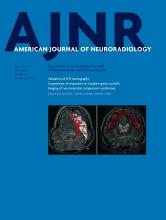Index by author
Anzai, Y.
- Head and Neck ImagingYou have accessDo Radiologists Report the TNM Staging in Radiology Reports for Head and Neck Cancers? A National Survey StudyB. Ko, U. Parvathaneni, P.A. Hudgins and Y. AnzaiAmerican Journal of Neuroradiology August 2016, 37 (8) 1504-1509; DOI: https://doi.org/10.3174/ajnr.A4742
Aviv, R.I.
- EDITOR'S CHOICEAdult BrainOpen AccessCortical Perfusion Alteration in Normal-Appearing Gray Matter Is Most Sensitive to Disease Progression in Relapsing-Remitting Multiple SclerosisS.-P. Hojjat, M. Kincal, R. Vitorino, C.G. Cantrell, A. Feinstein, L. Zhang, L. Lee, P. O'Connor, T.J. Carroll and R.I. AvivAmerican Journal of Neuroradiology August 2016, 37 (8) 1454-1461; DOI: https://doi.org/10.3174/ajnr.A4737
Bookend perfusion was used to quantify parameters in normal-appearing and lesional tissue at different relapsing-remitting MS stages in 39 patients and 19 age-matched healthy controls. Perfusion parameters such as CBF, CBV, and MTT were compared along with cognitive performance. White matter lesion but not cortical lesion perfusion was significantly reduced in cognitively impaired patients with relapsing-remitting MS versus unimpaired patients with relapsing-remitting MS. Perfusion reduction with disease progression was greater in normal-appearing gray matter and normal-appearing white matter compared with cortical lesions and white matter lesions. The authors conclude that the greatest changes are present within NAGM and NAWM, necessitating absolute rather than relative lesion perfusion measurement.
Bammer, R.
- Adult BrainYou have accessPerformance of CT ASPECTS and Collateral Score in Risk Stratification: Can Target Perfusion Profiles Be Predicted without Perfusion Imaging?S. Dehkharghani, R. Bammer, M. Straka, M. Bowen, J.W. Allen, S. Rangaraju, J. Kang, T. Gleason, C. Brasher and F. NahabAmerican Journal of Neuroradiology August 2016, 37 (8) 1399-1404; DOI: https://doi.org/10.3174/ajnr.A4727
Barton, J.J.S.
- Adult BrainOpen AccessReduced Myelin Water in the White Matter Tracts of Patients with Niemann-Pick Disease Type CJ. Davies-Thompson, I. Vavasour, M. Scheel, A. Rauscher and J.J.S. BartonAmerican Journal of Neuroradiology August 2016, 37 (8) 1487-1489; DOI: https://doi.org/10.3174/ajnr.A4719
Becker, M.
- Adult BrainOpen AccessImaging of Neurovascular Compression Syndromes: Trigeminal Neuralgia, Hemifacial Spasm, Vestibular Paroxysmia, and Glossopharyngeal NeuralgiaS. Haller, L. Etienne, E. Kövari, A.D. Varoquaux, H. Urbach and M. BeckerAmerican Journal of Neuroradiology August 2016, 37 (8) 1384-1392; DOI: https://doi.org/10.3174/ajnr.A4683
Booth, T.N.
- Pediatric NeuroimagingYou have accessSpectrum of Clinical and Associated MR Imaging Findings in Children with Olfactory AnomaliesT.N. Booth and N.K. RollinsAmerican Journal of Neuroradiology August 2016, 37 (8) 1541-1548; DOI: https://doi.org/10.3174/ajnr.A4738
Bowen, M.
- Adult BrainYou have accessPerformance of CT ASPECTS and Collateral Score in Risk Stratification: Can Target Perfusion Profiles Be Predicted without Perfusion Imaging?S. Dehkharghani, R. Bammer, M. Straka, M. Bowen, J.W. Allen, S. Rangaraju, J. Kang, T. Gleason, C. Brasher and F. NahabAmerican Journal of Neuroradiology August 2016, 37 (8) 1399-1404; DOI: https://doi.org/10.3174/ajnr.A4727
Boxerman, J.L.
- EDITOR'S CHOICEAdult BrainOpen AccessImproved Leakage Correction for Single-Echo Dynamic Susceptibility Contrast Perfusion MRI Estimates of Relative Cerebral Blood Volume in High-Grade Gliomas by Accounting for Bidirectional Contrast Agent ExchangeK. Leu, J.L. Boxerman, T.F. Cloughesy, A. Lai, P.L. Nghiemphu, L.M. Liau, W.B. Pope and B.M. EllingsonAmerican Journal of Neuroradiology August 2016, 37 (8) 1440-1446; DOI: https://doi.org/10.3174/ajnr.A4759
The authors' hypothesis is that incorporating bidirectional contrast agent transport into the DSC MR imaging signal model will improve rCBV estimates in brain tumors. A unidirectional contrast agent extravasation model (Boxerman-Weisskoff) was compared with a bidirectional contrast agent exchange model. For both models, they compared the goodness of fit with the parent leakage-contaminated relaxation rate curves and the difference between modeled interstitial relaxation rate curves and dynamic contrast-enhanced MR imaging in 21 patients with glioblastoma. The authors conclude that the bidirectional model more accurately corrects for the T1 or T2* enhancement arising from contrast agent extravasation due to blood-brain barrier disruption in high-grade gliomas by incorporating interstitial washout rates into the DSC MR imaging relaxation rate model.
Brasher, C.
- Adult BrainYou have accessPerformance of CT ASPECTS and Collateral Score in Risk Stratification: Can Target Perfusion Profiles Be Predicted without Perfusion Imaging?S. Dehkharghani, R. Bammer, M. Straka, M. Bowen, J.W. Allen, S. Rangaraju, J. Kang, T. Gleason, C. Brasher and F. NahabAmerican Journal of Neuroradiology August 2016, 37 (8) 1399-1404; DOI: https://doi.org/10.3174/ajnr.A4727
Brinjikji, W.
- Adult BrainYou have accessPrevalence of Intracranial Aneurysms in Patients with Connective Tissue Diseases: A Retrospective StudyS.T. Kim, W. Brinjikji and D.F. KallmesAmerican Journal of Neuroradiology August 2016, 37 (8) 1422-1426; DOI: https://doi.org/10.3174/ajnr.A4718
- Adult BrainYou have accessNeurovascular Manifestations of Hereditary Hemorrhagic Telangiectasia: A Consecutive Series of 376 Patients during 15 YearsW. Brinjikji, V.N. Iyer, V. Yamaki, G. Lanzino, H.J. Cloft, K.R. Thielen, K.L. Swanson and C.P. WoodAmerican Journal of Neuroradiology August 2016, 37 (8) 1479-1486; DOI: https://doi.org/10.3174/ajnr.A4762








